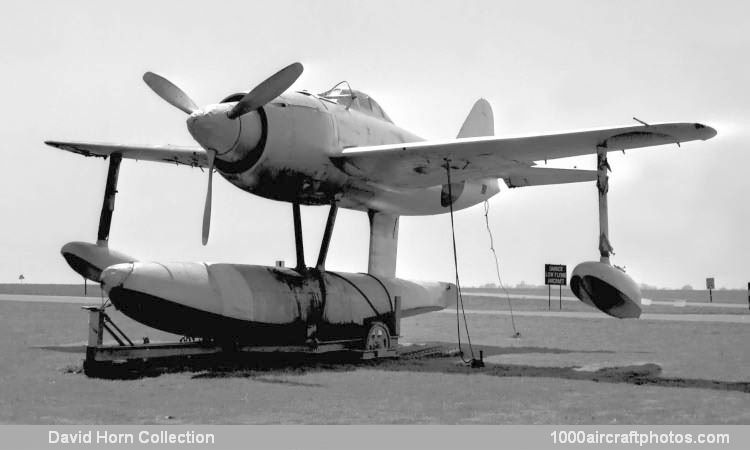07/31/2019. Remarks by Johan Visschedijk: "The pictured aircraft is one of at least five N1K1s brought to the USA:
C/n 514 arrived in 1946 at NAS Patuxent River, Maryland for evaluation, in the late 1940s it was stored at NAS Norfolk, Virginia. In 1972 it was transferred to the Smithsonian Institution, initially it was placed in outdoor storage at NASM's Paul E. Garber Restoration and Storage Facility, Silver Hill, Maryland, in 1975 it was stored indoors.
C/n 562 arrived at NAS Norfolk and was stored until 1965, when it was transferred to the Smithsonian and stored at NASM's Garber facility. On February 12, 1976 it was loaned to the Fleet Admiral Chester W. Nimitz Naval Museum, Fredericksburg, Texas, where it was on display until placed in storage in the early 1990s. Subsequently Ownership transferred to the National Museum of Naval Aviation, Pensacola, Florida. By 2009 the aircraft had been refurbished, cleaned and repainted, and subsequently put on display at the National Museum of the Pacific War, Fredericksburg, Texas.
C/n 565 arrived in 1946 at NAS Patuxent River. On October 7, 1946 it was transferred to Naval Aviation Supply Depot, Philadelphia, Pennsylvania. By 1958 it was on display at nearby NAS Willow Grove, as pictured above and here. In 1999 it was transferred to the National Museum of Naval Aviation, and stored pending restoration.
"FE-324" was the USAAF Foreign Equipment code given to another N1K1 (no c/n available), when it was captured at Sasebo, Kyushu Island, Japan. It was shipped from Yokosuka on November 16, 1945 on USS Core (CVE-13), arriving NAS Alameda, California. It was transferred to the T-2 Office of Air Force Intelligence, Technical Data Laboratory, Air Materiel Command, Wright Field, Dayton, Ohio and renumbered as "T2-324". Next it was transferred to the Middletown Air Materiel Area, Middletown, Pennsylvania and became available for release to industry for evaluation on March 10, 1946. It was set aside for proposed national aviation museum and under restoration at Middletown in September 1946. On September 18 it was transferred to the 803rd Specialized Depot, Orchard Place Airport, Park Ridge, Illinois. Apparently not transferred to a museum it was scrapped at Park Ridge ca. 1950.
Yet another N1K1 (no c/n available), also captured at Sasebo, was shipped to NAS Patuxent River. On October 23, 1946 it was transferred to the Naval Shipyard at Boston, Massachusetts, for use as a static display, its fate is not known.
06/30/2009. Remarks by Johan Visschedijk: "The Imperial Japanese Navy Air Service (IJNAS) awarded Kawanishi a development contract for an advanced floatplane fighter in September 1940, and design work was begun immediately on the 15-Shi fighter, or K-20 as it was designated by the company, the design team including Shizuo Kikuhara, Toshiharu Baba, Elizaburo Adachi and Hiroyuki Inoue.
The first prototype was constructed at Kawanishi's Naruo plant, and flown for the first time on May 6, 1942. The K-20 was powered by a Mitsubishi MK4D Kasei (Mars) fourteen-cylinder air-cooled radial engine, geared for contra-rotating airscrews. The complexities of the gearing necessitated by the contra-props outweighed any advantages that these airscrews offered, and the second prototype was modified to take the 1,460 hp Kasei 13 engine which was similar to the Kasei 14 but drove a single three-bladed airscrew via an extension shaft.
The second prototype was completed in October 1942, and it was found to suffer seriously from the snaking during the take off run that the contra-props had been intended to safeguard against. It was found to call for extreme skill in correcting for torque, especially during take off, and the aircraft was seriously damaged during one of its first landings when the pilot over-corrected. However, four further prototypes had been completed by the end of the year, these being joined in the test program by two more prototypes at the beginning of 1943, and the most serious shortcomings of the design were progressively eliminated, although the fighter was always to demand considerable skill in taking-off and landing.
In December 1942, the K-20 was accepted by the IJNAS for production as the N1K1 Kyofu (Mighty Wind) Floatplane Fighter Model 11 at Kawanishi's Naruo and Himeji plants. Armament consisted of two 0.303 in (7.7 mm) Type 97 machine guns and two 0.787 in (20 mm)
Type 99 cannons. Production started slowly but began to gain tempo in June 1943, reaching a production peak in the following December in which month fifteen Kyofu fighters were delivered to bring deliveries to eighty-nine aircraft excluding prototypes in that year.
By that time, however, the war situation had changed, and the IJNAS was no longer faced by mediocre land-based Allied fighters, and a floatplane fighter, no matter how exceptional its performance had little chance of successfully opposing the newer Allied land-based fighters.
The Kyofu was allocated to operational units, and a number were sent to the South Pacific, but their operations were somewhat restricted owing to the radically changing combat conditions. They were used in the interception role at Balikpapan in the Dutch East Indies where they proved themselves to be rugged and highly efficient aircraft.
At the beginning of 1944, production of the Kyofu was tapered off in order to enable both the Namo and Himeji plants to concentrate on a landplane derivative of the design, the NIK1-J Shiden terminating in March with the ninety-seventh machine.
During the closing stages of the war, some Kyofu floatplanes were assigned to the Ohtsu Naval Air Corps, operating from Lake Biwa on the Japanese home island of Honshu. Late production examples of the Kyofu were powered by the MK4E Kasei 15 which differed only in minor details from the Kasei 13."
